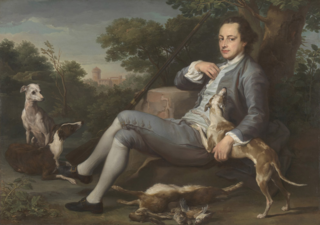
Pompeo Girolamo Batoni was an Italian painter who displayed a solid technical knowledge in his portrait work and in his numerous allegorical and mythological pictures. The high number of foreign visitors travelling throughout Italy and reaching Rome during their "Grand Tour" led the artist to specialize in portraits.

Allan Ramsay was a Scottish portrait-painter.

Prince William Henry, Duke of Gloucester and Edinburgh, was a grandson of George II and a younger brother of George III of the United Kingdom.

Prince Edward, Duke of York and Albany was a younger brother of George III of the United Kingdom and the second son of Frederick, Prince of Wales, and Princess Augusta of Saxe-Gotha.

Sebastiano Conca was an Italian painter.

Mary Thornycroft was a British sculptor who sculpted many different busts, fragments and statues. She frequently choose infants and children as her subjects and was commissioned by Queen Victoria to create a number of statues and portraits of her children and other members of the royal family. Several of these are now in the British Royal Collection.

The Athena Giustiniani or Minerva Giustiniani is a Roman marble statue of Pallas Athena, based on a Greek bronze sculpture of the late 5th–early 4th century BCE. Formerly in the collection of Vincenzo Giustiniani, it is now in the Vatican Museums.
James Byres of Tonley FRSE FSAScot FSA was a Scottish architect, antiquary and dealer in Old Master paintings and antiquities.

Lyde Browne was an 18th-century English antiquary and banker, who owned one of the largest antiquities collections of the time. This now forms the nucleus of the classical sculpture collections of the Hermitage Museum in Saint Petersburg and the Pavlovsk Palace in the city's suburbs. The Hermitage Museum website calls him John Lyde-Brown, as does The Oxford Encyclopedia of Ancient Greece and Rome.

General William Gordon, of Fyvie, was a British general and courtier. He was several times returned to Parliament by the interest of the Duke of Marlborough, and precipitated a family quarrel with his nephew, the Duke of Gordon, by commandeering a regiment that the latter was raising.

Johann Georg Ziesenis was a German–Danish portrait painter.

John Rolle Walter was Tory MP for Exeter in 1754–1776 and for Devon in 1776–1779. He held the honorary position of Town Recorder of Great Torrington in 1739–1779, due to his family's long-standing importance as the major local landowner.

David Morier, was an Anglo-Swiss painter of portraits, military subjects and historical scenes around and after the time of the War of the Austrian Succession and the related Jacobite rising of 1745.

Humphry Morice was a Whig Member of Parliament for the Cornish parliamentary borough of Launceston from 2 February 1750 until 1780.

Mary Fox, Baroness Holland, known as Lady Mary Fox from 1766–74, was an Anglo-Irish aristocrat from the Mac Giolla Phádraig dynasty and Fox family. She is best known for being the portrait subject of several notable 18th-century artists, including Thomas Gainsborough and Sir Joshua Reynolds.

An Incident in the Rebellion of 1745 is an oil painting painted by Swiss-born artist David Morier sometime between 1746 and 1765. It is currently part of the art collection of the British royal family. The painting depicts a scene during the 1746 Battle of Culloden, in which a group of Jacobite Army troops charge against a line of government soldiers.

The Marriage of Queen Victoria is an 1842 painting by the British artist George Hayter. It depicts the wedding between Queen Victoria, reigning monarch of the United Kingdom, and her prince consort Albert on 10 February 1840 at the Chapel Royal in St James's Palace in London.

George III is an 1809 portrait painting by the English artist Thomas Lawrence depicting the British monarch George III. It is an oil painting on canvas depicting the King in his robes for the State Opening of Parliament. It was commissioned by George as a gift for the former Prime Minister of the United Kingdom Henry Addington. George had reigned since 1760, but he was troubled by occasional bouts of mental instability. In 1810, shortly after celebrating the Golden Jubilee on the throne, George was overcome by a more lasting loss of control and his eldest son George was declared Prince Regent. The image by Lawrence continued to be used to represent the King throughout the remainder of his reign.

Portrait of Lord Moira is a portrait painting by the English artist Sir Joshua Reynolds of the Irish soldier and politician Francis Rawdon-Hastings, 1st Marquess of Hastings, then known as the Earl of Moira.

Portrait of the Duke of York is an 1816 portrait painting by the English artist Thomas Lawrence. It depicts Frederick, Duke of York, the Commander in Chief of the British Army. A royal duke, he was the second son of George III and younger brother of the Prince Regent. From 1820 to his death in 1827 he was heir presumptive to the British throne.


















